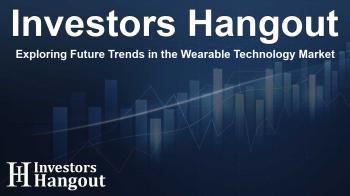Exploring Future Trends in the Wearable Technology Market

Significant Growth in the US Wearable Technology Market
As we enter a new era of technology, the wearable tech landscape is rapidly evolving, with cutting-edge innovations transforming our daily lives. The US wearable technology market is a testament to this growth, currently valued at an impressive USD 24 billion and anticipated to expand at a staggering compound annual growth rate (CAGR) of 15.4% through 2030.
Global Trends in Wearable Technology
A comprehensive global market analysis indicates that the overall wearable technology sector is expected to soar from USD 80 billion in 2024 to approximately USD 185 billion by 2030. This growth reflects a 15% CAGR, underscoring the increasing popularity of smart devices globally.
Market Drivers
Several factors are contributing to this upward trend. First and foremost is the heightened focus on health and wellness. There’s a growing demand for wearables that can monitor critical health metrics like heart rate and blood pressure. The integration of Internet of Things (IoT) capabilities allows wearables to communicate seamlessly with other smart devices, enabling real-time health tracking and personalized insights.
Technological Advancements
The advancement of sensor and display technologies also plays a significant role. Modern wearables are equipped with miniaturized sensors and flexible displays, making devices more compact and multifunctional. Furthermore, the incorporation of artificial intelligence enhances user experience by providing tailored health recommendations and predictive analytics, hence promoting proactive health management.
Emerging Market Opportunities
The opportunities for innovation in the wearable tech space are extensive. Healthcare monitoring is gaining traction, shifting from reactive to proactive health management. Wearables are increasingly being utilized for continuous health monitoring, allowing for real-time updates and communication with healthcare providers, which is particularly advantageous for remote care.
Broader Applications
Moreover, these devices are finding applications across various sectors including healthcare, fitness, military, and even enterprise solutions. The demand for smart clothing and sustainable wearable apparel is on the rise, reflecting a significant shift in consumer preferences towards eco-friendly products.
The Rise of Wrist-Worn Devices
Wrist-worn devices currently dominate the wearable technology market, capturing more than 58% of the global revenue in 2024. The increasing adoption of smartwatch models, particularly those designed for health and fitness monitoring, demonstrates significant consumer interest. Devices like the Apple Watch are now considered essential for many due to their ability to track crucial health parameters.
Competitive Landscape in Wearable Technology
In terms of market share, consumer electronics brands lead the convergence of wearable technology. With major players such as Apple and Samsung producing advanced smartwatches and fitness trackers, the competition remains fierce. For instance, Samsung shipped 11.5 million wearables in the first three quarters alone, emphasizing its robust market presence.
Future Prospects for North America
North America is forecasted to emerge as the fastest-growing market for wearable technology due to the concentration of tech giants like Apple and Alphabet. This region showcases a highly tech-savvy population that embraces the latest innovations. With comprehensive digital infrastructures and strong R&D environments, North America is positioned to lead advancements in wearable tech through the next decade.
Contact for More Information
For further insights into the wearable technology market or to explore tailored solutions, feel free to reach out to our dedicated team at Wissen Research. We pride ourselves on delivering high-quality market intelligence and strategic insights to help guide your business decisions.
Frequently Asked Questions
What is driving the growth of the US wearable technology market?
The growth is primarily driven by rising health consciousness, technological advancements, and the integration of IoT, which allows for real-time monitoring and data exchange.
What are the key segments in wearable technology?
The key segments include wrist-worn devices, fitness trackers, smart clothing, and embedded technology in other electronics.
How do wearables integrate with other smart devices?
Wearables can connect via Bluetooth and Wi-Fi, syncing data with smartphones and other devices for comprehensive health insights and functionality.
Why is North America the leading market for wearables?
North America's strong market leadership is due to its innovative tech companies, high urbanization rates, and a consumer base eager to adopt the latest technologies.
What future trends should we expect in wearable technology?
We anticipate more devices focusing on health monitoring, advancements in AI for personalized health insights, and greater adoption of smart clothing and accessories.
About The Author
Contact Caleb Price privately here. Or send an email with ATTN: Caleb Price as the subject to contact@investorshangout.com.
About Investors Hangout
Investors Hangout is a leading online stock forum for financial discussion and learning, offering a wide range of free tools and resources. It draws in traders of all levels, who exchange market knowledge, investigate trading tactics, and keep an eye on industry developments in real time. Featuring financial articles, stock message boards, quotes, charts, company profiles, and live news updates. Through cooperative learning and a wealth of informational resources, it helps users from novices creating their first portfolios to experts honing their techniques. Join Investors Hangout today: https://investorshangout.com/
The content of this article is based on factual, publicly available information and does not represent legal, financial, or investment advice. Investors Hangout does not offer financial advice, and the author is not a licensed financial advisor. Consult a qualified advisor before making any financial or investment decisions based on this article. This article should not be considered advice to purchase, sell, or hold any securities or other investments. If any of the material provided here is inaccurate, please contact us for corrections.

